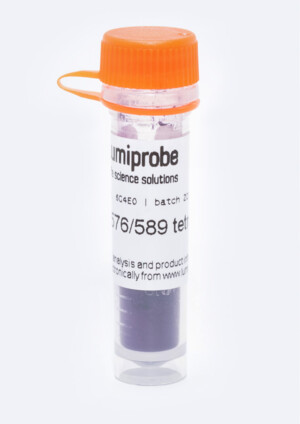BDP® 576/589 tetrazine
| Cat. # | Quantity | Price | Lead time | Buy this product |
|---|---|---|---|---|
| 1G4E0 | 1 mg |
$110
|
in stock | |
| 2G4E0 | 5 mg |
$290
|
in stock | |
| 3G4E0 | 10 mg |
$450
|
in stock | |
| 4G4E0 | 25 mg |
$690
|
in stock | |
| 5G4E0 | 50 mg |
$1270
|
in stock | |
| 6G4E0 | 100 mg |
$1990
|
in stock |

Because of its relatively long excited-state lifetime (about 5 nanoseconds), BDP 576/589 dye can be used in various methods based on measuring fluorescence lifetime. Similarly to other dyes of the BDP family, BDP 576/589 has strong hydrophobic properties and is suitable for labeling non-polar and lypophilic biomolecules and their subsequent visualization by fluorescent microscopy, including two-photon microscopy.
This reagent is a tetrazine derivative that can be conjugated with various strained dienophiles such as trans-cyclooctenes and cyclopropenes. This reaction (TCO ligation) is considered to be one of the best bioconjugation reactions because it is very fast and selective in physiological conditions and does not require additional catalyzers, so it is not toxic in vitro and in vivo.
BDP 576/589 absorbance and emission spectra

Customers also purchased with this product
General properties
| Appearance: | dark colored solid |
| Mass spec M+ increment: | 501.16 |
| Molecular weight: | 529.17 |
| Molecular formula: | C26H23N8BF2O |
| Solubility: | good in polar organic solvents |
| Quality control: | NMR 1H, HPLC-MS (95%) |
| Storage conditions: | Storage: 24 months after receival at -20°C in the dark. Transportation: at room temperature for up to 3 weeks. Avoid prolonged exposure to light. Desiccate. |
| MSDS: | Download |
| Product specifications |
Spectral properties
| Excitation/absorption maximum, nm: | 580 |
| ε, L⋅mol−1⋅cm−1: | 98000 |
| Emission maximum, nm: | 592 |
| Fluorescence quantum yield: | 0.13 |
| CF260: | 0.32 |
| CF280: | 0.35 |





















 $
$ 
